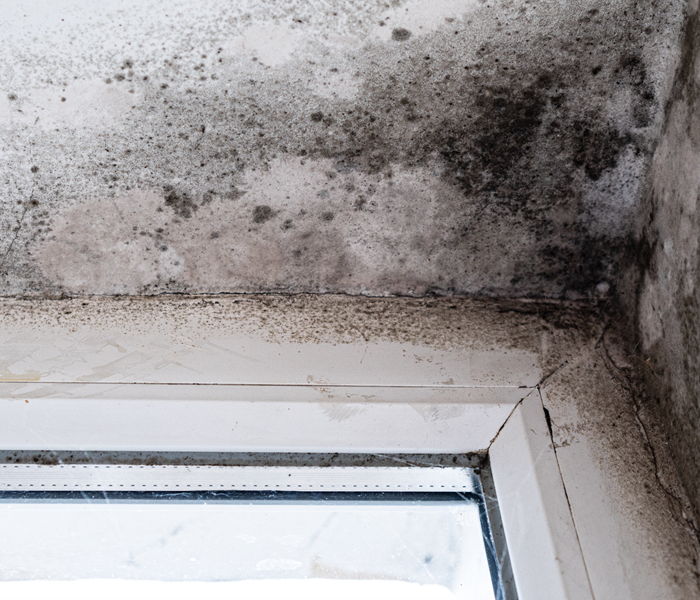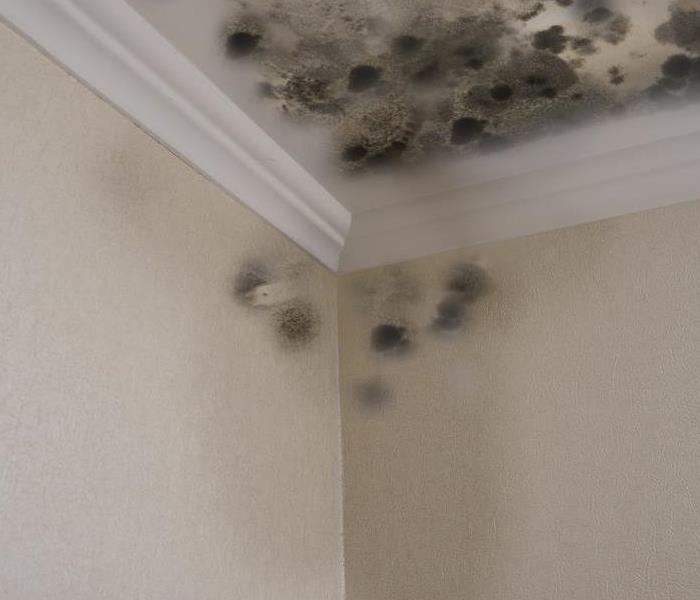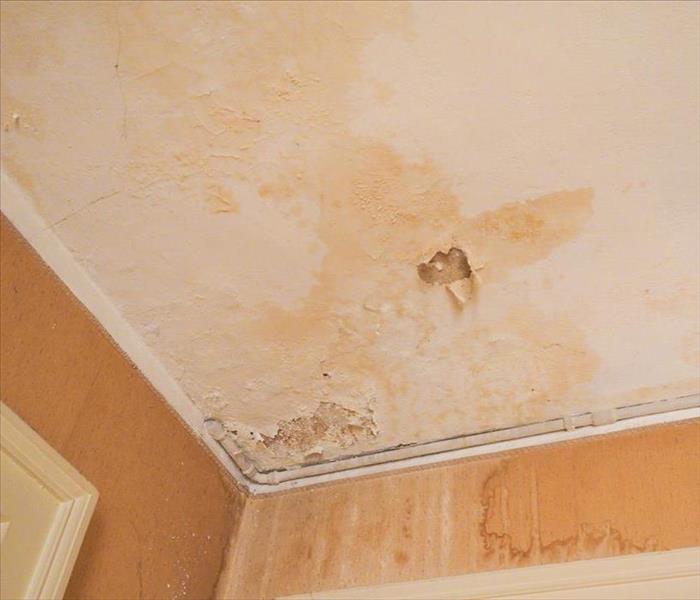Recent Mold Remediation Posts
How Mold Sneaks into HVAC Systems
3/13/2024 (Permalink)
Mold, the silent infiltrator, can find its way into the most unexpected places, including your HVAC system. Let's unravel the not-so-mysterious ways mold manages to take residence in residential and commercial HVAC systems.
1. Dampness Breeds Opportunity
Mold is a moisture enthusiast, and your HVAC system provides an ideal breeding ground if there's even a hint of dampness. Condensation on coils, drip pans, or any accumulated water within the system becomes an open invitation for mold to thrive. Regular checks for moisture buildup are your first line of defense.
2. Filters as Gateways
HVAC filters, tasked with trapping dust and debris, can inadvertently become gateways for mold. When filters are not changed regularly, they accumulate moisture and become an attractive habitat for mold growth. Routine filter replacement is a simple yet effective preventive measure.
3. Dark Corners and Ductwork
Dark and secluded spaces within the HVAC system, especially in ductwork, offer the perfect hideout for mold. Dust, debris, and moisture create a cozy environment for mold spores to settle and multiply. Regular duct inspections and cleaning are essential to keep mold at bay.
4. Neglected Maintenance
HVAC systems require regular maintenance to function efficiently. Neglected maintenance, however, is like rolling out the welcome mat for mold. Dust, debris, and unchecked moisture during routine checks provide the ideal conditions for mold to establish its presence.
5. Outdoor Influences
The great outdoors can be both beautiful and problematic. Mold spores from outside can infiltrate your HVAC system through vents, especially if they are not properly sealed. Ensuring your vents are adequately sealed and protected can significantly reduce the chances of outdoor mold making itself at home.
6. High Humidity
Regions with high humidity levels create an environment where mold feels right at home. HVAC systems in such areas must work harder to control indoor humidity. Ensuring your HVAC system is equipped to manage humidity effectively is crucial in preventing mold growth.
In conclusion, understanding how mold creeps into HVAC systems is the first step in keeping it at bay. Regular maintenance, moisture control, and a proactive approach to filter replacement are your biggest allies in the battle against mold growth. By staying ahead of these factors, you can ensure that your HVAC system remains a mold-free zone, contributing to a healthier and more comfortable indoor environment.
Dehumidifiers and Mold Prevention: What You Need to Know
10/29/2023 (Permalink)
 Dehumidifiers are a practical solution for preventing mold growth in your home or business
Dehumidifiers are a practical solution for preventing mold growth in your home or business
Dehumidifiers can play a significant role in preventing mold growth in your home by controlling moisture levels. Excess humidity creates an ideal environment for mold to thrive, making dehumidifiers a valuable tool in maintaining a mold-free living space. In this blog, we will explore the benefits of dehumidifiers for mold prevention and provide essential information on how to use these devices effectively.
How Dehumidifiers Work
Dehumidifiers operate by drawing in humid air and passing it over a cold coil, causing the moisture to condense and collect in a reservoir. The dehumidifier then expels dry air back into the room, effectively reducing the relative humidity. These devices can be placed in various areas of the home, such as basements, crawl spaces, and bathrooms, to control moisture levels and inhibit mold growth.
Ideal Humidity Levels
Maintaining proper humidity levels is crucial for mold prevention. A relative humidity level below 60% is recommended for indoor spaces. When humidity exceeds this threshold, it creates a favorable environment for mold to flourish. Dehumidifiers can help regulate humidity levels, preventing mold growth and addressing issues related to excessive moisture, such as musty odors and the proliferation of allergens and dust mites.
Choosing the Right Dehumidifier
Selecting the appropriate dehumidifier depends on several factors. Consider the size of the area you want to dehumidify, the prevalent moisture level, and the capacity of the dehumidifier. Larger spaces or areas with high humidity may require a dehumidifier with a higher capacity. Look for features such as automatic shut-off or built-in humidity sensors to avoid over-drying the air. Energy Star certified dehumidifiers are also recommended for environmental friendliness and cost-effectiveness.
Maintenance and Care
Routine maintenance and proper care are essential for the optimal performance and longevity of your dehumidifier. Empty and clean the water reservoir regularly to prevent mold growth and ensure efficient operation. Replace air filters every three to six months, and place the unit in a well-ventilated area. Regular cleaning and maintenance contribute to mold prevention while extending the lifespan of the dehumidifier.
In addition to mold prevention, dehumidifiers offer a range of other benefits for your home. By reducing excess moisture, these devices help protect your belongings from damage caused by dampness, such as warping wood furniture or peeling wallpaper. Dehumidifiers also contribute to improved indoor air quality by minimizing the growth of mold, mildew, and dust mites, which can trigger allergies and respiratory issues. Furthermore, by lowering humidity levels, dehumidifiers create a more comfortable living environment, especially during hot and humid summer months. With their ability to prevent mold growth and provide numerous advantages, dehumidifiers are a worthwhile investment for maintaining a healthy and enjoyable home.
Dehumidifiers are a practical solution for preventing mold growth by controlling moisture levels in your home. By selecting the right dehumidifier, maintaining proper humidity levels, and practicing regular care and maintenance, you can effectively safeguard your living space from mold infestations and enjoy a mold-free environment.
Keeping Your Employees Safe During Mold Removal: Tips and Best Practices
5/17/2023 (Permalink)
 Take steps to ensure your workspace is mold free.
Take steps to ensure your workspace is mold free.
Mold growth in the workplace can be a serious issue, and it's important to address it promptly and effectively. However, mold remediation can also be a hazardous process, and it's essential to take steps to keep your employees safe during the removal process. In this blog post, we will discuss some tips and best practices to help ensure the safety of your employees during mold removal.
Conduct a thorough risk assessment
Before any mold removal work begins, it's essential to conduct a thorough risk assessment of the affected area. This assessment should identify any potential hazards, such as electrical wiring or plumbing, that could pose a risk to workers during the removal process. It's also important to assess the potential exposure of workers to mold spores and other contaminants.
Provide appropriate personal protective equipment (PPE)
Personal protective equipment (PPE) is essential for keeping workers safe during mold removal. The type of PPE required will depend on the level of risk identified in the risk assessment. At a minimum, workers should wear gloves, eye protection, and respiratory protection to prevent exposure to mold spores and other contaminants.
Ensure proper ventilation
Proper ventilation is essential during mold removal to prevent the buildup of mold spores and other contaminants in the air. This can be achieved through the use of industrial-strength fans or through the use of negative air pressure, which involves creating a vacuum to draw contaminated air out of the affected area.
Train workers in proper mold removal techniques
Proper training is essential for ensuring that workers understand how to remove mold safely and effectively. This includes understanding how to use PPE properly, how to handle contaminated materials, and how to dispose of moldy materials safely. Workers should also be trained in the proper use of cleaning agents and equipment.
Follow industry best practices
There are established best practices for mold removal, and it's important to follow these guidelines to ensure the safety of workers. These guidelines include using appropriate cleaning agents, sealing off the affected area, and disposing of contaminated materials properly.
Monitor worker exposure
During the mold removal process, it's important to monitor the exposure of workers to mold spores and other contaminants. This can be achieved through the use of air monitoring equipment, which can detect the presence of mold spores in the air. Monitoring worker exposure can help identify any potential risks and allow for appropriate measures to be taken to protect workers.
In conclusion, mold remediation can be a hazardous process, but there are steps you can take to keep your employees safe during the removal process. Conducting a thorough risk assessment, providing appropriate PPE, ensuring proper ventilation, training workers in proper mold removal techniques, following industry best practices, and monitoring worker exposure can all help ensure the safety of workers during mold removal. By taking these steps, you can help ensure that your workplace is a safe and healthy environment for all employees.
Basic Facts About Mold
2/13/2023 (Permalink)
 Here are some basic facts about mold.
Here are some basic facts about mold.
Molds are fungi that grow on organic matter, such as wood and food. They're common in nature, but they can also grow in your home or business if you have moisture problems. Here are some basic facts about mold:
Mold is a type of fungi.
Mold is a type of fungus. The word “fungus” comes from Latin, meaning “mushroom” or “sponge.” Fungi are eukaryotic organisms that do not have chlorophyll and produce spores for reproduction. They grow in either the presence or absence of light, depending on the species and environmental conditions.
Fungi are classified as protists (single-celled organisms), but they don't fit neatly into this category because they have characteristics that are not found in other protists (like plants).
Molds are found indoors and outdoors.
Molds are found indoors and outdoors. The spores can be found on surfaces, in the air, and even in the soil.
Mold spores can be found everywhere: on walls, windowsills, furniture, and other products you use daily. The spores can easily spread from surfaces into the air. This is how easy it is to spread mold within your home. Mold spores can easily be introduced into your home through your open doors, windows, and even your HVAC unit. The presence of mold spores does not mean that you have a damaging mold infestation in your home or business. It isn't until the spores are introduced to a source of water, such as a water leak or excess humidity, that the mold can begin to grow, spread, and cause serious damage.
How common is mold?
Mold is very common in homes and businesses. In fact, it's estimated that anywhere from 40-50% of homes have mold problems. Mold can be found in many areas of your home or business, including:
- Carpeting and fabric
- Upholstery
- Woodwork or other porous surfaces
Mold can also grow on food. If you find mold growing on fruits or vegetables in your refrigerator, throw them away immediately.
How to keep mold out of your home or business?
Though it is impossible to completely prevent the chances of a mold infestation breaking out on your property, there are several steps to take to reduce the risks of a mold infestation, including:
- Keep the humidity in your home below 50%.
- Clean up leaks quickly.
- Keep your building well-ventilated.
- Keep humid areas such as bathrooms, kitchens, attics, and basements well-ventilated.
Be careful!
If you do find mold, it's important to act immediately. Mold can spread quickly and cause serious damage if left untreated. The best course of action after discovering a mold infestation is to call a professional for help.
Mold is a type of fungus that grows on decaying organic matter. It can also grow indoors and outdoors, but when it does grow indoors it can be damaging to your property and belongings. If you see mold anywhere in your home or business, you should call a professional for help as quickly as possible in order to prevent any further damage.





 24/7 Emergency Service
24/7 Emergency Service


